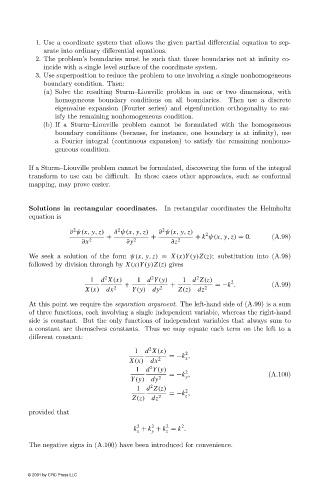Page 495 - Electromagnetics
P. 495
1. Use a coordinate system that allows the given partial differential equation to sep-
arate into ordinary differential equations.
2. The problem’s boundaries must be such that those boundaries not at infinity co-
incide with a single level surface of the coordinate system.
3. Use superposition to reduce the problem to one involving a single nonhomogeneous
boundary condition. Then:
(a) Solve the resulting Sturm–Liouville problem in one or two dimensions, with
homogeneous boundary conditions on all boundaries. Then use a discrete
eigenvalue expansion (Fourier series) and eigenfunction orthogonality to sat-
isfy the remaining nonhomogeneous condition.
(b) If a Sturm–Liouville problem cannot be formulated with the homogeneous
boundary conditions (because, for instance, one boundary is at infinity), use
a Fourier integral (continuous expansion) to satisfy the remaining nonhomo-
geneous condition.
If a Sturm–Liouville problem cannot be formulated, discovering the form of the integral
transform to use can be difficult. In these cases other approaches, such as conformal
mapping, may prove easier.
Solutions in rectangular coordinates. In rectangular coordinates the Helmholtz
equation is
2
2
2
∂ ψ(x, y, z) ∂ ψ(x, y, z) ∂ ψ(x, y, z) 2
+ + + k ψ(x, y, z) = 0. (A.98)
∂x 2 ∂y 2 ∂z 2
We seek a solution of the form ψ(x, y, z) = X(x)Y(y)Z(z); substitution into (A.98)
followed by division through by X(x)Y(y)Z(z) gives
2
2
2
1 d X(x) 1 d Y(y) 1 d Z(z) 2
+ + =−k . (A.99)
X(x) dx 2 Y(y) dy 2 Z(z) dz 2
At this point we require the separation argument. The left-hand side of (A.99) is a sum
of three functions, each involving a single independent variable, whereas the right-hand
side is constant. But the only functions of independent variables that always sum to
a constant are themselves constants. Thus we may equate each term on the left to a
different constant:
2
1 d X(x) 2
=−k ,
x
X(x) dx 2
2
1 d Y(y) 2
=−k , (A.100)
y
Y(y) dy 2
2
1 d Z(z) 2
=−k ,
z
Z(z) dz 2
provided that
2
2
2
2
k + k + k = k .
x y z
The negative signs in (A.100) have been introduced for convenience.
© 2001 by CRC Press LLC

